From the Black Sea to the White Sea or 2012: Spring or Winter of Tourism in Egypt? Part 1: Analytical.
Alexey SOLOVIEV,
Editor of the BSNews Tourism Section and English Version, photos by the author
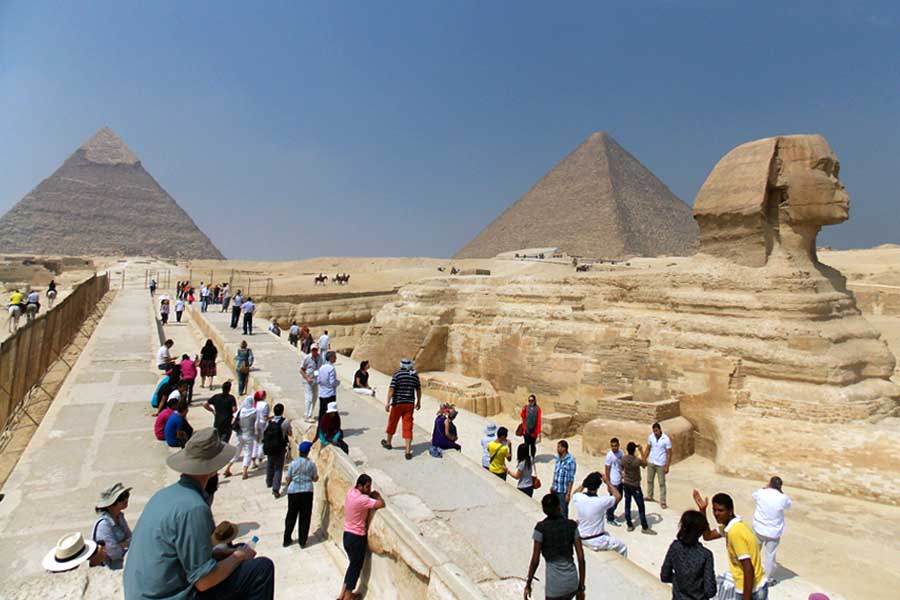
Arabian proverb: Anyone in this world is afraid of time, while time fears none, but the Pyramids or the Giza Pyramids will always lure tourists to Egypt. Photo by Alexey Soloviev, BSNews
At the end of September 2012 yours truly made the analytical-nostalgic journey from the Black to the White Sea.
But don’t expect to find here the northern latitudes’ story, as we’ll focus on the Congress of FIJET (Federation of International Journalists and Travel Writers), which started in Cairo, and continued in Alexandria by the Mediterranean Sea, which in the modern Arabic is referred to as al-Bahr al-Abyad al-Mutawassit or the White Middle Sea, and called simply the White Sea or Akdeniz in the nearby Turkey.
This voyage was a great opportunity to see the modern Egypt's tourism industry achievements, recollect and analyze the changes in the Egyptian and Crimean tourism since 1977, when I happened to make the similar journey for the first time, being then a Soviet university student.
In the far away year of 1977 of the bygone XX century, the only way to get to Cairo from the Crimea, the most popular resort playground of huge, nonexistent now country, was through the capital of the USSR, Moscow. At that time little did I expect that Egypt, the very first visited by me foreign country, would become the place to embark on my career in both tourism and travel writing.
Apart from my primary employment, I, like the other translators at the construction of the Iron and Steel complex in the Cairo suburb of Helwan, was obliged to conduct tours for the Soviet experts on some weekends, as well as to write guide book type descriptions of the Egyptian Museum, the Faiyum Oasis, the Pyramids of Giza and Saqqara and other tourist destinations of the country.
Still, it gave me an opportunity to travel around the country, and to compare the level of tourism development in Egypt, and in the Crimea, which was then visited annually by about 6-8 million Soviet people, which had the right to spent their holidays predominantly inside their own country.
Egypt, on one hand in 1972 welcomed just about 541.000 visitors and for a long time in the seventies the tourists flow remained approximately at this level; the development of future competitors of the Crimea, its seaside resorts, was just getting started: they say that the very first hotel in Hurghada was opened only in 1974. On the other hand Cairo already had famous Nile Hilton (built in 1959) and hotels of the other international chains, and in the same Hurghada the year of 1978 was the take-off point of the economic reforms and this resort town has now about 200 hotels.
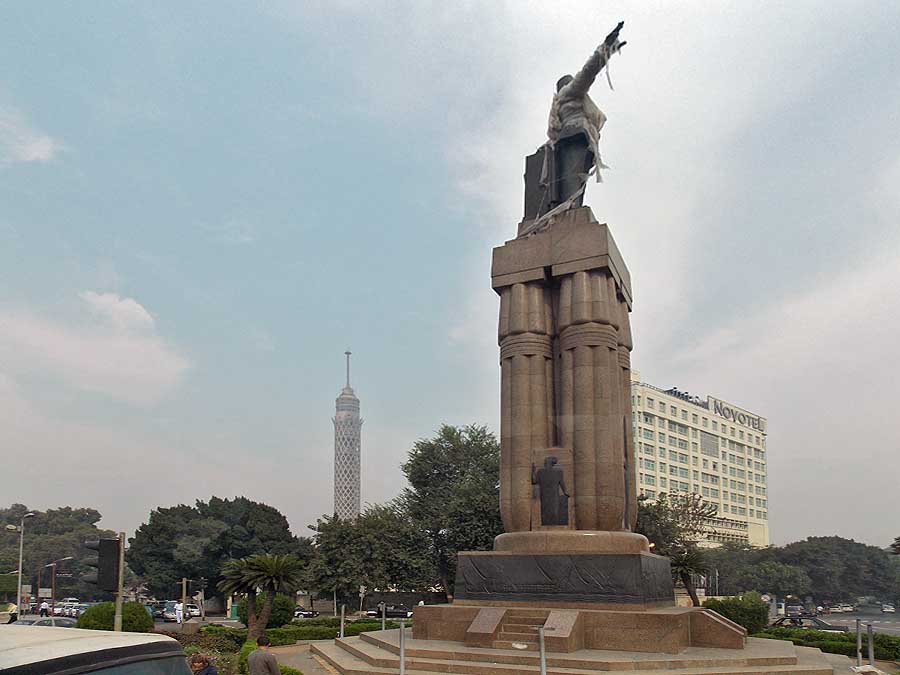
From left: the Cairo Tower, Gamal Abdel Nasser’s favorite lunch spot (187 m, 1961); statue of Saad Zaghlul, leader of struggle for complete independence of Egypt from the UK; Hotel Novotel Cairo El Borg (built in 1950, refurbished in 2008). Photo by Alexey Soloviev, BSNews
The point is that a year from autumn 1977 to autumn 1978, the year which I spent in Egypt, appeared to be a real pivotal turn.
I witnessed the development of dramatic changes in the country: Anwar Sadat, the then ruler of Egypt, in November 1977 visited Israel and addressed the Knesset, and then in 1978 began the Camp David negotiations, which resulted in the 1979 agreement, which envisaged the return of the Sinai peninsula to Egypt. For the country it meant the end of the era of Nasser, friendship with the Soviet Union, and an abrupt turnabout towards the west.
But peace agreement with Israel brought to the region stability together with tourism development opportunities. 1979 saw the beginning of the foreign capital inflow, and in 1980 the above mentioned Hurghada started to enjoy not just Egyptian, but foreign investments as well. Though in 1981, Anwar Sadat was assassinated, the intensive development of Egyptian tourism continued under Hosni Mubarak.
In the first half of the 80’s, the tourists numbers for a long time used to remain in the level of about 1.5 million people, i.e. of the year of 1982, when the country was visited by 1.4 million tourists, and industry revenue reached $ 300 million. But in the same 80’s, the Egyptian government had adopted a program of beach tourism in the Red Sea area, in 1983, Hurghada officially developed into resort town and in the mid 80's in Egypt there was commencement of an intensive construction of hotels and development of mass tourism from the leading Western countries.
This was facilitated by the government's reforms in the currency exchange regulations, hotel rates, charter operations and measures to develop new airports. In 1987 1.8 million foreign tourists visited Egypt, an average length of stay reached 8.8 days per a tourist, revenues of tourism industry hit about $ 2 billion.
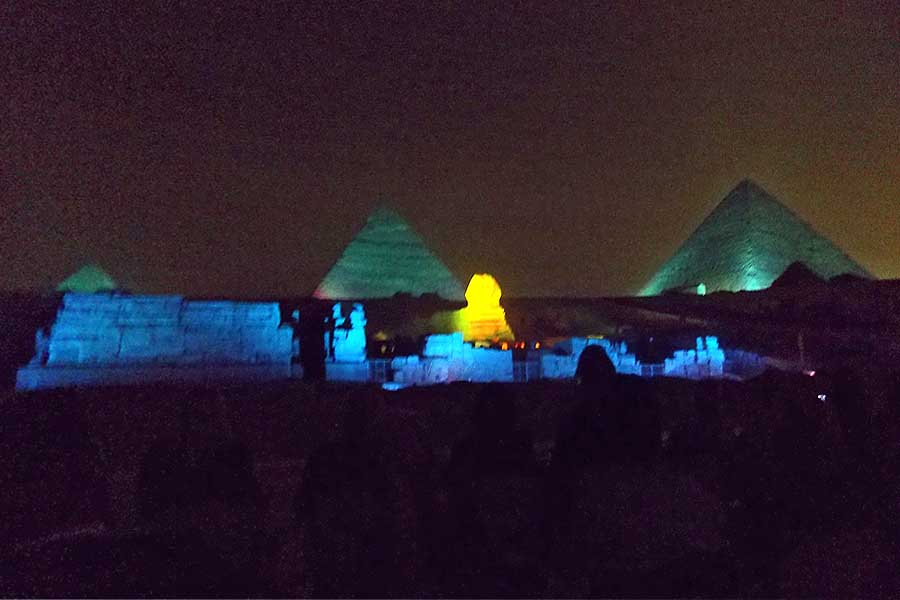
In 1961 the Sound & Light show at the Giza Pyramids had its first performance, in 1977 it was featured in famous James Bond movie - The Spy Who Loved Me. Photo by Alexey Soloviev, BSNews
At this time in the Soviet Union a quiet revolution or perestroika was already going on, and in 1991 it lead first to the total collapse of the economy, and then of the whole country. Intourist, Trade Unions and other organizations responsible for tourism industry and its marketing vanished immediately.
Since that time, the Crimea, the former chief resort of the huge closed state, would desperately strive for survival and struggle for every former Soviet tourist who suddenly run into opportunity to enjoy hospitality of any tourist destination of the whole world.
In 1992 the number of foreign tourists in Egypt reached 1.67 million, in 1993 Hurghada welcomed one of the very first charters with the Russian tourists. At a time when, in the Crimea they closed usual hotels and health resort hotels (called locally sanatoria), in Egypt from 1990 to 1999 the number of hotels increased from 632 to 914, the expansion of amount of hotel rooms and beds climbed up to almost 85%. In 1998 the quantity of tourists amounted to 4 million, which meant the growth of 269% over the 90ies.
Compared with the 80's, the number of tourists in 2000 has almost tripled and reached 5.5 million. Amount of rooms increased to 107 thousand, while average occupancy rate got to 73%. The Presidential Decree of 2000 envisaged establishment of Higher Council of Tourism under authority of the Prime Minister. At that time the Ministry of Tourism of Egypt estimated the direct and indirect income from tourism and related industries at 11.3% of GDP, given that about 70 types of different business activities are linked with provision of tourist services. The same period saw intensive construction of new airports. Their number has gradually increased from 17 to 30. In modern Egypt there are about 80 airports, 9 of them - international.
In 2003, the country welcomed 6,000,000 tourists, industry revenues exceeded $ 6 billion. In 2007, the number of tourists amounted to 9 million and they spent 89 million nights in Egypt. 1, 5 million of them were from Russia, and tourist flow from England and Germany was almost a million from each country. Tourist spending in Egypt reached about $ 8 billion, and tourism sector and its related industries accounted for 40% of services export and provided 20% of total employment in the country.
And 30 years later, I happened to visit Egypt again.
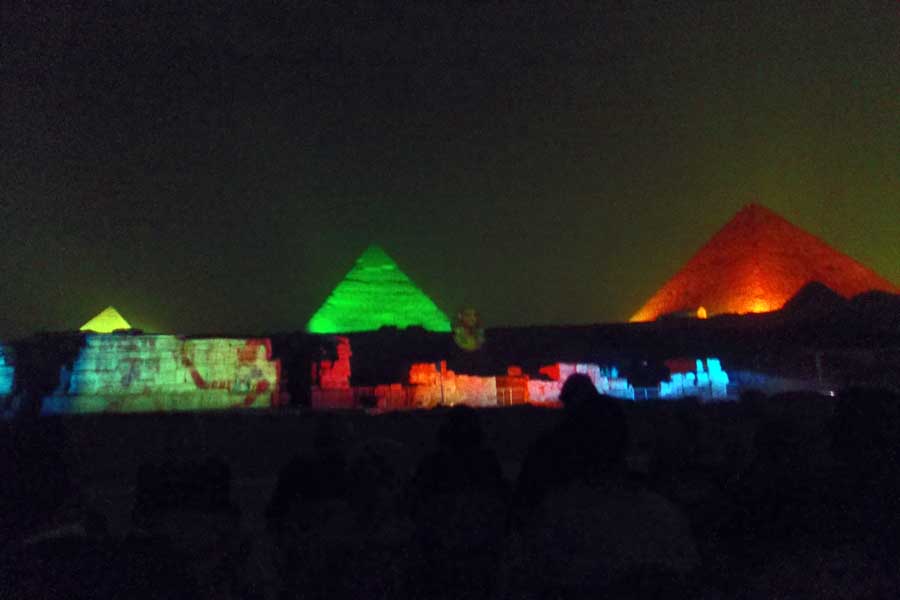
Since its first performance in 1961 the Giza Pyramids' Sound & Light show has developed into an excellent example of modern sound, light and laser show combination. Photo by Alexey Soloviev, BSNews
Then, in 2008, we flew to Cairo by plane of one of the Ukrainian airlines from Kiev, the capital of already independent Ukraine. In comparison with 1978 the city has changed dramatically: modern roads, flyovers and hotels of all international chains. I do not want to judge Hosni Mubarak, neither as a politician nor as a personality, as only Egyptians, who know all the problems of his epoch or reign in details, are able to give an objective judgment, but the fact remains that during his time tourism in Egypt has achieved considerable and successful development.
The statistics vividly proves it: in 2008 the country had over 12.8 million tourists, and industry revenues were $ 11 billion. In 2009, the year of the global financial crisis, there was a small decline - 12.5 million foreign tourists, 2.3% less than in 2008, and revenues reached 10.6 billion dollars. These figures would have been even lower if not the tourists from Russia, which number, compared to 2008 increased by 13%, reaching more than 2 million people and about 15% of the total flow of foreign tourists.
However, the peak of the tourism development in Egypt was reached in 2010: revenues from tourism amounted to $ 12.5 billion, daily spending of tourists climbed to $ 85, and the country welcomed a record-breaking number of tourists in its history: more than 14 million tourists, of which 2.8 million were tourists from Russia.
In January-February 2011 Egypt experienced about 18 days of the revolutionary events, which ended with resignation of Hosni Mubarak, a former military pilot, who had ruled the country for about 30 years. The experience of my country prompted that any political dislocation did not favor the tourism development. As for Egypt, in 2011 the country was visited by 9.8 million tourists only.
And, here comes the autumn of 2012: the number of flights from the Ukrainian capital to Cairo has reduced greatly and, saying goodbye to the Black Sea in Yalta, once the most famous all Soviet Union, and now the main Black Sea resort of independent Ukraine, I, together with my friends, cover the distance of 90 km, and arrive at the airport of Simferopol. A Turkish Airlines plane quickly covers the distance of 659 km. from Simferopol to Istanbul and here we are: walking around the city on shores of the strategic Bosphorus, the border between Europe and Asia.
A few hours later, by the other plane of the same Turkish Airlines, we cover the distance of 1293 km., and land at the Cairo airport, the second largest airport in Africa after Johannesburg, which usually provides services to about 16 million passengers per year, of which approximately 15 million - are tourists.
Thus, we are in the capital city of the other strategically located, transcontinental country: Egypt spans the continents of Asia (Sinai Peninsula) and Africa. The Suez Canal makes a conventional boundary between them and links the Mediterranean with the Red Sea. This largest in the world man-made, lock-free canal is the shortest route from the Atlantic to the Indian Ocean. When about 8 years (1967-1975) the Suez Canal was closed as a result of the war with Israel, the waterway between Western Europe and the countries of the Indian Ocean increased by almost 8,000 km. Alternate route shot up the transport costs by 60%.
In the fiscal year of 2009-2010 the Suez Canal operation brought in $ 4.5 billion, in 2011 - $ 5.22 billion. On average, about 30 thousand vessels sail through the canal annually, including 3 thousand tankers. Here it is apt to remark that another major Egypt’s income generator is production of oil and gas, which accounted for between 6 to 10 percent of GDP in 2005-2009.
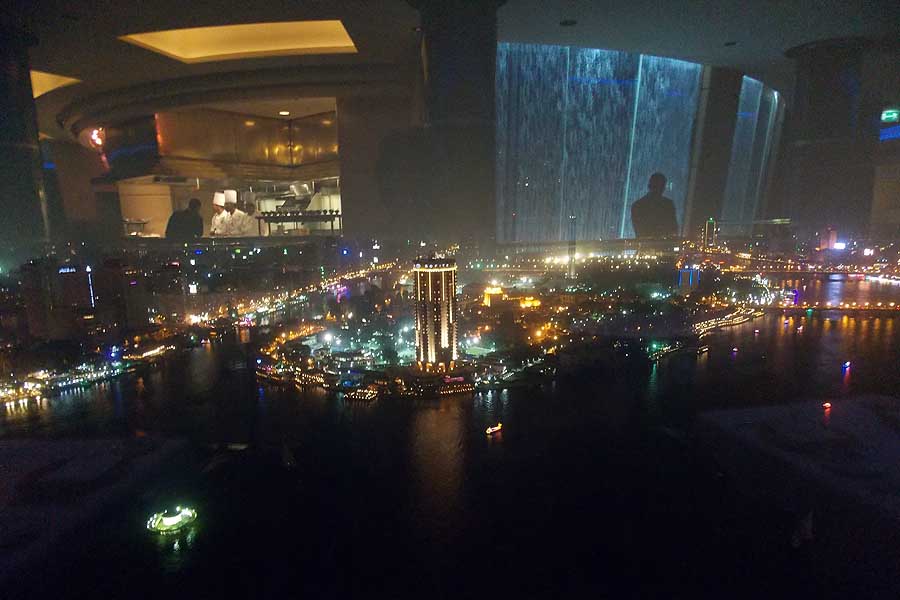
The view of the Nile and hotel Sofitel El Gezirah Cairo from the revolving French cuisine restaurant of the Grand Nile Tower Hotel. Photo by Alexey Soloviev, BSNews
Still, tourism is one of the most important for the Egyptian economy, so the 54th FIJET (World Federation of Travel Journalists and Writers) Congress, attended by about 150 delegates from 22 countries, was mostly focused on challenges and trends of this industry in Egypt and was held in its two major cities - Cairo and Alexandria from September 28 to October 4, 2012.
The Congress delegates were immediately introduced to Egypt’s achievements in tourism, as they were accommodated in the exclusive 5 star Hotel Sofitel El Gezirah Cairo. Rooms of this circular, 27-storey building offer grand views of the Africa’s largest - 17 million - city, and the mighty Nile, the longest river of the world.
The revolving French cuisine restaurant on the 40-th floor of the Hotel Grand Nile Tower, located in the city center not far from the famous Egyptian Museum, offers even more breath-taking view. Tour of this magnificent 41 storey five-star hotel, formerly known as the Grand Hyatt Cairo, proved that it has everything to bestow high quality recreational experience. Dinner at one of its restaurants became the sheer demonstration of Egyptian chefs’ skill in cooking of both European and Egyptian dishes. Freshly squeezed juices of papaya, mango, guava and strawberry, and, of course, the famous Egyptian oranges, really crowned the end of dinner, added local, exotic touch and emphasized the Egypt cuisine potential.
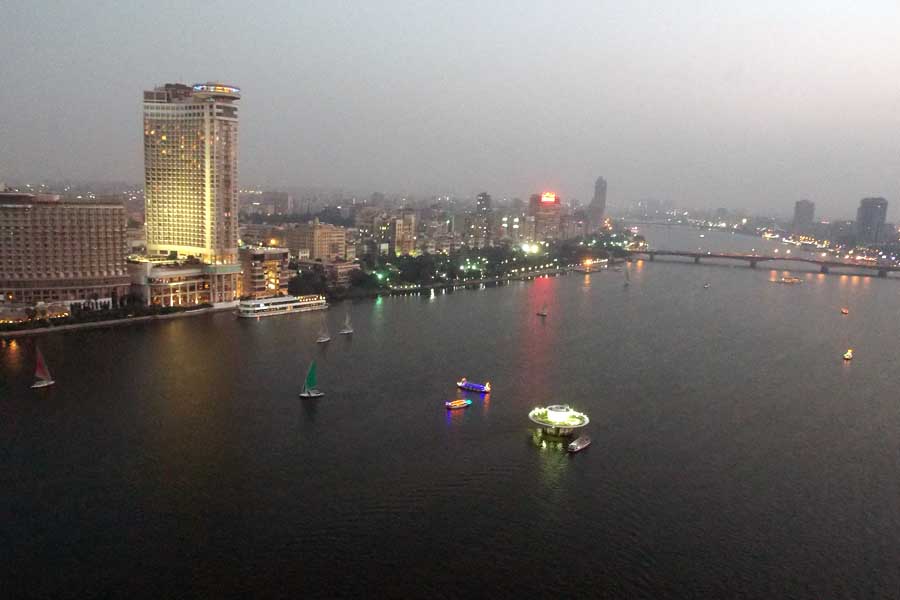
The view of the Nile and the Grand Nile Tower Hotel with the revolving French cuisine restaurant on its 40th floor. Photo by Alexey Soloviev, BSNews
The Opening of 54th Congress of FIJET took place on September 29, 2012 in no less luxurious famous five-star hotel Four Seasons Nile Plaza not far from the Tahrir Square of the downtown Cairo.
In his speech at the Congress Opening the FIJET President Mr. Tijani Haddad emphasized that journalists of founded over 56 years ago organization with about one thousand members had arrived in Egypt to support the tourism industry of the country during its difficult times. He added that FIJET purpose is promotion of international tourism without borders and the development of tourism as a means of peace, tolerance and understanding.
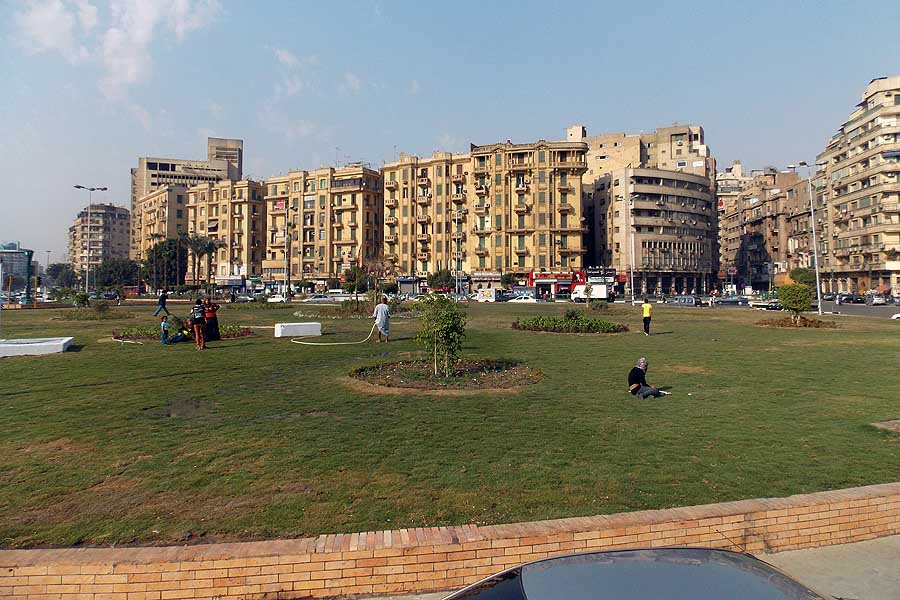
Midan at-Tahrir or the Tahrir Square or the Liberation Square, September 2012. Photo by Alexey Soloviev, BSNews
Mr. Tijani Haddad thanked for hospitality Mr. Hisham Zaazou, newly appointed Minister of Tourism of Egypt, who was present at the Congress Opening. It seems that Egypt is quite fortunate to have the new minister of tourism with more than 30 years experience in various positions of the tourism sector and, thus, with the first hand knowledge of tourism theory, and most importantly, of its practice. In his speech he highlighted the fact that the government considers tourism one of the priority sectors.
Indeed, statistics brilliantly demonstrates that tourism provides to up 11.3% of Egypt’s GDP and directly employs more than 4 million people, or 12.6% of the total workforce, and indirectly grants employment to nearly 14 million Egyptians. Tourism accounts for more than 20% of foreign currency revenues or brings in 29 cents out of every € 1 of income.
Mr. Hisham Zaazou assumes that in 2013 the number of tourists would reach 15 million. By 2020 the government of Egypt plans to increase the number of visitors up to about 30 million and achieve the income level of $ 25 billion – i.e. two times more than in 2010, when tourism revenues hit about $ 12.5 billion. According to Mr. Hisham Zaazou, growth in the number of tourists, will be generated by such countries as Argentina, Brazil, India, China and Russia.
Mass media reported that 8.1 million tourists visited Egypt by the end of September, tourist industry revenues amounted to $ 10 billion.
It is difficult to define now what season has come for Egyptian tourist market which roughly can be segmented into beach-resort (about 70-80%) and cultural-historical (18-20%).
But in the autumn of 2012, Egyptian mass media revealed that due to political instability national tourist industry started to loose about 267 million dollars a week. At that time this was true mostly for cultural and historical tourism segment, developed mainly in Cairo, Luxor and Aswan, and partly in Alexandria. But then the reports claimed that the late 2012 events started to affect the occupancy rates at the Egyptian beach resorts.
In Egypt tourism has once again reiterated the truth of the axiom that it is one of the most profitable and interesting, but at the same time - one of the most vulnerable businesses. And it does not matter where, by which: the Black, Red or White sea you live, one thing is clear: reports of the world press about instability lead to the almost immediate decline of tourist flow, which starts to search for the new or return to the old, well-known tourist centers. And then wonderful climate, nature and history of your area are of no matter, any tourist would prefer them to the other place in the world which offers comfort, physical and psychological one.
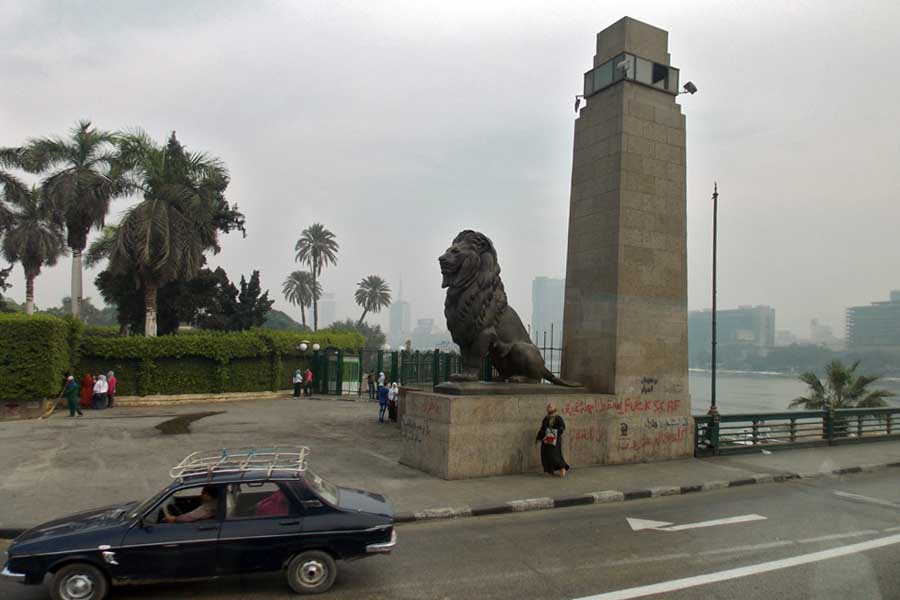
The Lion statue at the Qasr al-Nil Bridge, linking the Gezirah/Zamalek island with the Tahrir Square and downtown Cairo. Photo by Alexey Soloviev, BSNews
My more than 30 years work experience in international tourism gave me opportunity to meet a lot of people from many countries of all continents of the world. A lot of them used to ask me the same question: "What is the nowadays attitude of the citizens of the former Soviet Union to Mikhail Gorbachev, and started by him perestroika?" Usually there was no time for a detailed answer, and gradually, after analysis of the events of perstroika, I began to answer with the phrase: "It is an attitude to a doctor, who started a surgical operation, but, alas, the patient did not survive and passed away."
I do not want to delve into the specifics of political processes in Egypt. But any revolutionary developments, changes and reforms - it's like a surgical operation. The one who takes the responsibility to perform it, should always think about its outcome ...
To be continued...